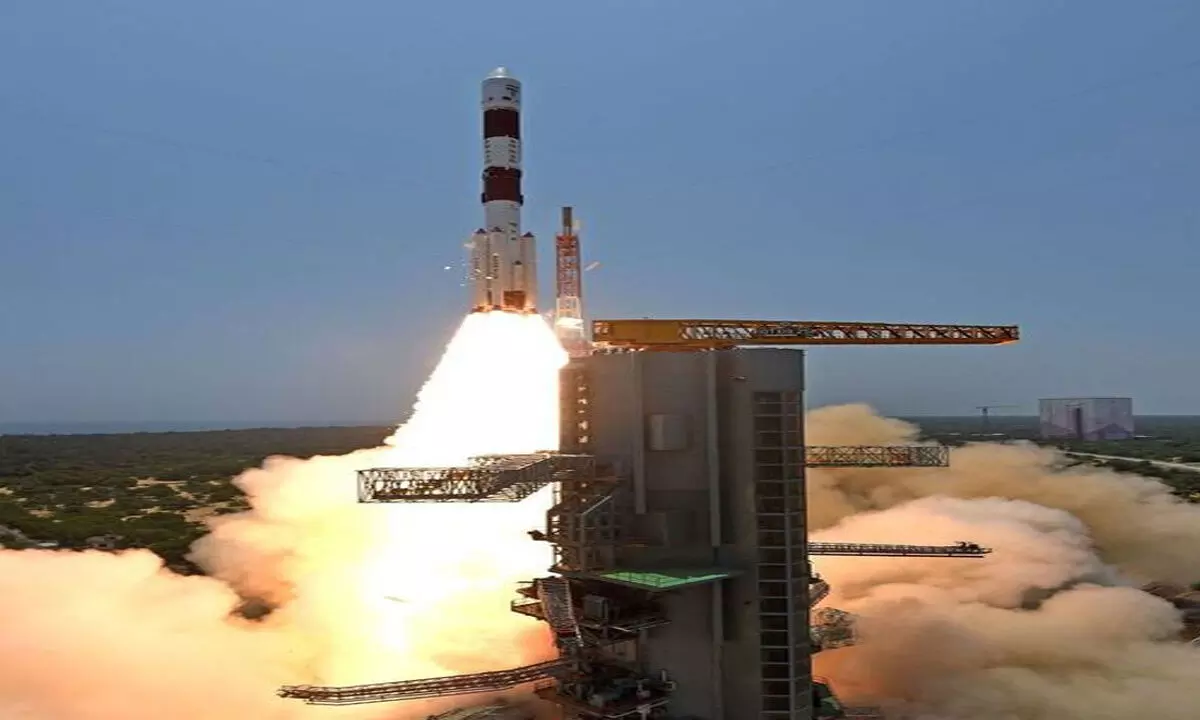Live
- They always want me to win, and now I feel lucky to have been offered a story like ‘Zebra’: Satyadev Kancharana
- ‘Democracy first, humanity first’: PM Modi in Guyana's parliament on two countries' similarities
- PKL Season 11: Telugu Titans register third straight win to top standings
- Is Pollution Contributing to Your COPD?
- NASA Unveils Underwater Robots for Exploring Jupiter's Moons
- Additional Central forces arrive in violence-hit Manipur
- AR Rahman and Saira Banu’s Divorce: Legal Insights into Common Issues in Bollywood Marriages
- 82.7 pc work completed in HPCL Rajasthan Refinery area: official
- Curfew relaxation extended in 5 Manipur districts on Friday
- Tab scam prompts Bengal govt to adopt caution over fund disbursement
Just In

ISRO's launch vehicle PSLV-C57 rocket carrying India's first solar mission, 'Aditya-L1', lifts off from the Satish Dhawan Space Centre, in Sriharikota on Saturday
- The 44.4 meter tall Polar Satellite Launch Vehicle (PSLV) soared majestically at the prefixed time of 11.50 am
- It was PSLV's longest flight of about 63 minutes
- Aditya L1 will travel about
- 1.5 million km rom the Earth over 125 days
- It will be placed in a Halo orbit around the Lagrangian point L1 considered closest to the Sun
- It will send pictures of the sun for scientific experiments
- At a Lagrange point, celestial sweet spot, the gravitational pull of the two large bodies (the Sun and the Earth) equals the necessary centripetal force required for a small object to move with them
- The major objectives of the mission include understanding the Coronal Heating and Solar Wind Acceleration, the initiation of Coronal Mass Ejection (CME), near-earth space weather and the solar wind distribution
Sriharikota: India hits yet another historic milestone with the launch of Aditya L1, the first observation mission to the Sun on Saturday, about 20 days after launch of its moon mission which had made history by becoming the first to land near the Moon’s South Pole.
This marks the country's inaugural foray into space-based solar studies and promises to provide crucial insights into the Sun's activities and their implications for the Earth, experts say.
In a significant leap for the country's space exploration endeavours, the solar mission is carrying seven payloads for a detailed study of the Sun.
Aditya L-1 will be on 125-day journey to the Sun in its attempt to study various elements relating to Earth's nearest star, after being put into orbit by a PSLV rocket that touched a new technical milestone in the launch vehicle segment.
The European Space Agency (ESA) is lending a crucial hand in two significant ways: by offering deep space communication services and aiding ISRO in validating critical new flight dynamics software.
Communication is an essential part of every space mission. Without ground station support, it is impossible to get any science data from a spacecraft, to know how it is doing, to know if it is safe or even to know where it is, ESA said. “ESA's global network of deep space tracking stations and use of internationally recognised technical standards allows us to help our partners track, command, and receive data from their spacecraft almost anywhere in the solar system,” said Ramesh Chellathurai, ESA Service Manager and ESA Cross-Support Liaison Officer for ISRO. “For the Aditya-L1 mission, we are providing support from all three of our 35-metre deep space antennas in Australia, Spain, and Argentina, as well as support from our Kourou station in French Guiana and coordinated support from goon hilly Earth Station in the UK," Chellathurai said in a statement.
ESA said it is also the main provider of ground station services for Aditya-L1. ESA stations are supporting the mission from beginning to end, the space agency said. The support ranges from the critical ‘Launch and Early Orbit Phase’, throughout the journey to L1, and to send commands to and receive science data from Aditya-L1 for multiple hours per day over the next two years of routine operations.

© 2024 Hyderabad Media House Limited/The Hans India. All rights reserved. Powered by hocalwire.com







